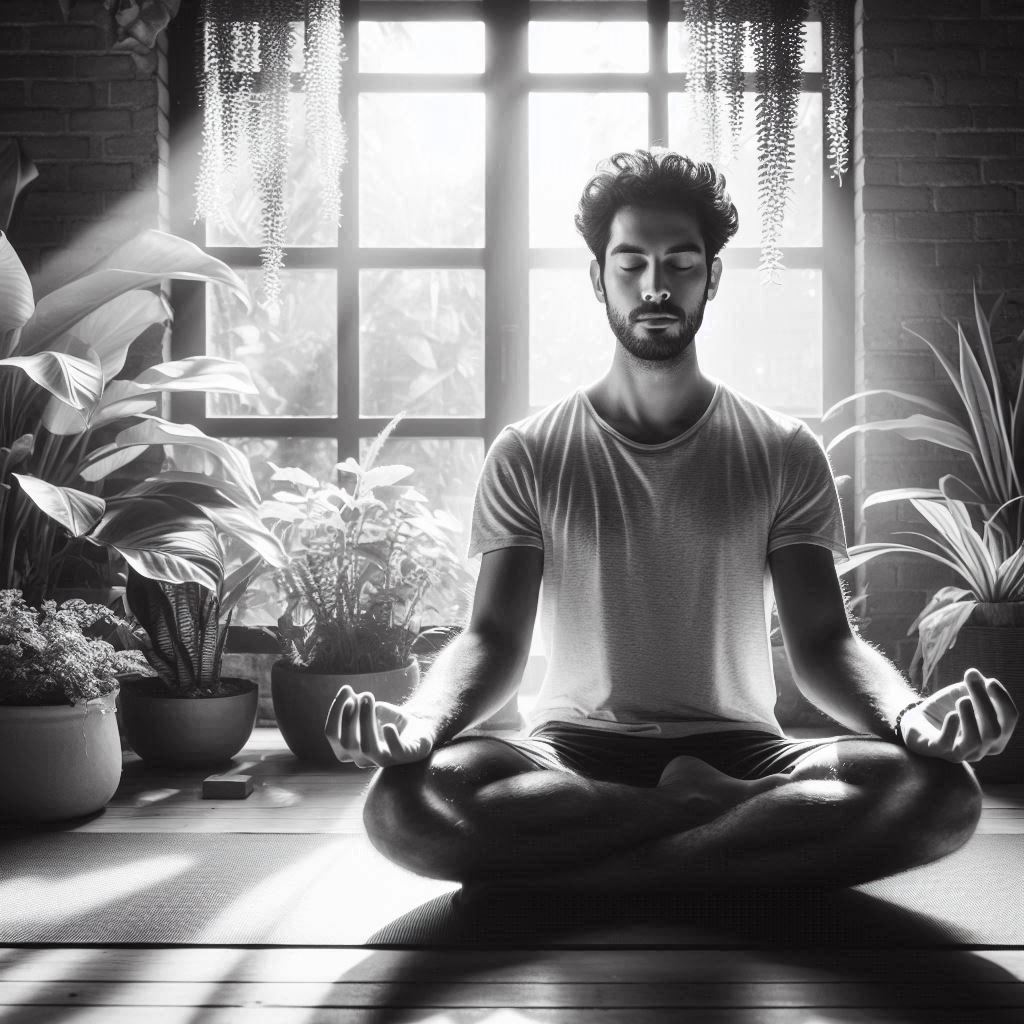Stress and tension seem unavoidable in today’s busy world, but body scan meditation offers a simple way to find calm. This beginner-friendly practice helps you reconnect with your body, promoting relaxation and mindfulness.
By tuning in to each area of your body, you can ease physical discomfort and quiet a restless mind. Whether you’re new to meditation or looking for a fresh approach, this technique is a great starting point for mental clarity and stress relief.
Understanding Body Scan Meditation
Body scan meditation is a powerful yet simple technique designed to help you connect with your body. It’s an effective way to relax, manage stress, and develop mindfulness by focusing your attention on physical sensations. Unlike other forms of meditation that focus on breathing or visualization, this practice draws your awareness inward, one body part at a time.
Definition of Body Scan Meditation
Body scan meditation is a mindfulness practice where you mentally check in with each part of your body. You start from one end—usually the head or toes—and work your way through, focusing on sensations, tension, or areas of discomfort. This process develops body awareness and encourages a deep sense of relaxation.
It’s not complicated, which makes it great for beginners or anyone looking for a grounding meditation technique. The goal isn’t to change how your body feels but simply to notice. Think of it as taking a mindful inventory of yourself, without judgment. Whether you feel tension, ease, or even numbness, the practice is about accepting your experience as it is in the moment.
Historical Context
Body scan meditation has its roots in ancient mindfulness practices, particularly those from Buddhist traditions. It’s a key component of mindfulness-based stress reduction (MBSR), a modern program developed in the late 1970s by Dr. Jon Kabat-Zinn.
While the MBSR framework made the practice widely known in the West, its origins trace back thousands of years to meditation techniques intended to cultivate awareness and reduce suffering.
In Buddhism, mindfulness of the body is emphasized in practices like Vipassana meditation, where observing bodily sensations plays a critical role in self-awareness and insight. This connection to mindfulness teachings highlights the enduring value of tuning into the body as a way to calm the mind and ease stress. Today, body scan meditation is embraced globally for its simplicity and transformative benefits, bridging ancient wisdom with modern wellness.
Benefits of Body Scan Meditation
Body scan meditation isn’t just a relaxation tool—it’s a transformative practice with real-life benefits. Whether you feel overwhelmed, distracted, or emotionally drained, this technique can help you reset and recharge. Let’s explore the key advantages it brings, from reducing stress to fostering emotional balance.
Stress Reduction
One of the biggest benefits of body scan meditation is its ability to ease stress. By focusing on physical sensations, you shift your attention away from anxious thoughts and into the present moment. This practice helps calm the nervous system, reducing the production of stress hormones like cortisol.
Think of it as hitting the “pause” button on your daily worries. Instead of being stuck in overthinking mode, you give yourself permission to simply feel—tension in your shoulders, tightness in your jaw, or even the sensation of your feet grounded to the floor. Each breath and focus on sensation trains your body to relax. Over time, this habit can create a healthier stress response.
Improved Focus
Body scan meditation is also an effective tool for sharpening concentration. By guiding your awareness to specific parts of your body, you learn to focus on one thing at a time. This skill naturally carries over into daily life, making it easier to stay present and productive.
Consider this: in a world filled with distractions, how often do we truly pay attention? Practicing body scans trains your mind to notice details without judgment—whether it’s the feeling of your fingers resting on a desk or the sound of your own breathing. This attention to subtle details enhances your ability to focus on tasks, goals, or conversations without your thoughts wandering.
Promoting Sleep
Struggling to fall asleep? Body scan meditation is a natural remedy for racing thoughts and restlessness at night. By creating a mindful relaxation routine, you signal your brain that it’s time to wind down. Many find that completing a body scan right before bed helps release tension and invite sleep more easily.
When you’re lying in bed, instead of replaying your to-do list or worrying about tomorrow, you gently guide your attention through your body. This not only quiets mental chatter but also soothes physical discomfort that might keep you awake. Over time, incorporating a body scan into your bedtime routine can lead to deeper, more restorative sleep.
Emotional Awareness
Another powerful aspect of body scan meditation is how it improves emotional awareness. We often store emotions in our bodies without realizing it—like stress in our neck or sadness in our chest. By tuning into these sensations, you can uncover and process feelings you might otherwise ignore.
This awareness doesn’t force you to fix anything. Instead, it teaches you to acknowledge emotions with curiosity rather than judgment. If you notice tightness in your stomach, for example, you might realize you’re feeling anxious about an upcoming event. Recognizing this helps you respond more thoughtfully, whether it’s through self-compassion, a calming activity, or talking things out with someone you trust.
How to Practice Body Scan Meditation
Body scan meditation is a straightforward yet powerful way to connect with your body and mind. When approached with intention, it can help reduce stress, deepen self-awareness, and bring a sense of calm. If you’re new to this practice, here’s how to get started.
Preparing for the Session
Before diving into body scan meditation, setting up the right environment and mindset is essential. Think of this as laying the foundation for a successful practice. Here’s what you’ll need to do:
- Find a Quiet Space: Choose a place where you won’t be disturbed. It doesn’t have to be perfectly silent, but a calm atmosphere helps.
- Position Yourself Comfortably: Sit in a chair, lie on a couch, or even rest on the floor—whatever feels natural. Use a yoga mat, cushion, or blanket for added support if needed.
- Set Aside Time: Aim for 10–20 minutes to start. You don’t need a long session; consistency matters more.
- Eliminate Distractions: Silence your phone and let others know not to disturb you. The fewer interruptions, the better.
- Tune Your Mindset: Approach the session with curiosity, not judgment. You’re not trying to fix anything—just observe.
Taking a few moments to prepare creates the space your mind needs to relax and focus. This setup helps make the experience smoother and more rewarding.
Step-by-Step Guide
Ready to begin? Follow this simple, step-by-step process to practice body scan meditation. Move at your own pace, and remember—there’s no right or wrong way to feel.
- Get Comfortable: Start by sitting or lying down in your prepared space. Close your eyes if it feels comfortable, or soften your gaze.
- Take a Few Deep Breaths: Breathe in deeply through your nose, then exhale slowly through your mouth. Focus on the sensation of your breath entering and leaving your body.
- Start at Your Feet: Bring your attention to your toes. Notice any sensations—tingling, warmth, tension—or the absence of feeling. Simply observe without judgment.
- Move Up Gradually: Shift your focus to your ankles, then your lower legs, knees, and thighs. Pause at each part to notice physical sensations or tension.
- Continue to Your Torso: Pay attention to your hips, lower back, stomach, and chest. Tune in to how each area feels as you breathe naturally.
- Focus on Your Hands and Arms: Move up from your fingertips to your wrists, forearms, elbows, and shoulders. Take your time as you scan.
- Move to Your Head and Neck: Finally, bring your awareness to your neck, jaw, face, and the top of your head. Notice any tension or relaxation.
- Pause and Reflect: Once you’ve scanned your entire body, take a moment to notice how you feel overall. Rest in this state of awareness for a minute or two.
- End Slowly: Gently wiggle your fingers and toes, then open your eyes if they’re closed. Take a final deep breath before returning to your day.
This sequence can be adjusted to fit your preferences. If you feel rushed, focus on fewer areas of the body. The key is to stay present and accept whatever you notice. Like any skill, body scan meditation improves with regular practice.
Common Challenges and Solutions
Body scan meditation, while simple, can come with challenges, especially for beginners. Feeling restless, dealing with physical discomfort, or facing emotional reactions are all common. The good news? These obstacles can be overcome with practical strategies and a bit of patience. Here’s how to address some of the most frequent challenges people encounter during this practice.
Difficulty Staying Focused
It’s normal for your mind to wander when practicing body scan meditation, especially if you’re new to it. Our brains are used to multitasking, and focusing on just one thing can feel unnatural at first. But staying focused is a skill you can strengthen over time.
Here are a few tips to help you maintain focus:
- Start with short sessions: Begin with 5–10 minutes instead of trying to sit for a full 20 minutes. Gradually increase the duration as you get more comfortable.
- Use a guided meditation: A recorded guide can help you stay on track by giving you gentle cues to refocus.
- Acknowledge wandering thoughts: Instead of getting frustrated, simply notice when your mind drifts. Then, gently bring your focus back to the area of your body you’re scanning.
- Focus on your breath briefly: If you catch yourself losing focus, pause for a moment to take a few mindful breaths before continuing.
Think of focus like a muscle. The more you practice redirecting your attention, the stronger it gets over time.
Physical Discomfort
Sitting or lying still for an extended period can cause stiffness, soreness, or even mild pain. This discomfort can make it hard to stay present during meditation. But instead of avoiding these sensations, try to approach them with curiosity.
Consider the following strategies to manage physical discomfort:
- Adjust your position: There’s no rule saying you have to stay in one position. If you feel discomfort, shift gently to a more comfortable posture without judgment.
- Use supportive props: Cushions or rolled-up blankets under your knees, back, or neck can provide extra comfort.
- Engage with the sensation: Instead of resisting discomfort, bring your attention to it. What does it feel like—sharp, dull, warm, or tight? Sometimes just observing the sensation reduces its intensity.
- Set realistic expectations: Your body might need time to adapt to sitting or lying still. Give yourself grace as you build endurance and find what works best.
Discomfort can be like background noise; with practice, you’ll learn to notice it without letting it dominate your experience.
Emotional Distress
Body scan meditation often brings heightened awareness to physical sensations and emotions. For some, this can mean encountering feelings of sadness, anxiety, or even frustration they may not have been conscious of before. While this can feel overwhelming, it’s also an opportunity for growth.
Here’s how to handle emotional distress that arises:
- Accept emotions as they come: Remind yourself that emotions are temporary. They’re like waves—they rise, peak, and eventually pass.
- Pause if needed: If an emotion feels too intense, take a break. Step away from the practice, have some water, or take a few deep breaths.
- Label your feelings: Simply naming your emotions (e.g., “I’m feeling anxious”) can reduce their intensity and help you process them.
- Seek support if necessary: If emotions consistently feel unmanageable, talking to a therapist or trusted friend can provide relief and insight.
Emotional reactions during meditation are a natural part of connecting with yourself. With compassion and practice, it gets easier to navigate them without judgment or fear.
Tips for a Successful Practice
Starting a body scan meditation practice is exciting, but creating the right conditions is key to making it stick. Beginners often face challenges like distractions, inconsistent routines, or feeling unsure about the process. By setting yourself up for success, you can build a sustainable and rewarding meditation habit.
Creating a Calm Environment
Your surroundings have a big impact on your meditation experience. A calm, inviting space helps your mind and body settle into relaxation. Here’s how to create an ideal environment:
- Choose a Quiet Space: Find a location away from loud noises and interruptions. If silence isn’t possible, soft background sounds like nature, white noise, or calming music can help.
- Dim the Lights: Lowering the brightness in a room naturally signals your body to relax. If meditating during the day, use curtains or blinds to reduce glare.
- Keep It Comfortable: Use cushions, blankets, or a yoga mat for support. Ensure your temperature is comfortable by adjusting the thermostat or layering clothing.
- Declutter Your Space: A neat, tidy area minimizes mental distractions. A clean environment can help you feel balanced and focused.
- Add Personal Touches: Adding candles, essential oils, or plants can help create a soothing atmosphere. Scents like lavender or chamomile may enhance relaxation.
Think of your meditation space as a sanctuary—a dedicated area that promotes stillness and mindfulness.
Setting a Regular Schedule
Consistency is one of the most important factors in mastering body scan meditation. Like any skill, it improves with repetition. Creating a routine doesn’t have to be complicated—start small, and let it grow.
- Start with Short Sessions: For beginners, 5–10 minutes is a great place to start. Gradually increase the time as you feel comfortable.
- Pick the Same Time Daily: Anchoring your practice to a specific time helps make it a habit. Whether it’s first thing in the morning or before bed, choose a slot that fits naturally into your daily life.
- Use Calendar Reminders: Set up alerts on your phone or planner to keep meditation top of mind. Making it part of your schedule increases follow-through.
- Pair It With Existing Habits: Attach meditation to an activity you already do, like brushing your teeth or drinking morning coffee. This creates an automatic trigger.
Think of meditation like brushing your teeth—it’s a small, consistent effort that creates lasting benefits over time.
Using Guided Meditations
Guided meditations are a great resource, particularly for beginners. They provide structure, direction, and encouragement, helping you stay focused throughout the practice.
- Apps and Websites: Platforms like Calm, Insight Timer, or Headspace offer a range of body scan meditations tailored to different levels and goals.
- Free Resources: YouTube, podcast platforms, and other free channels often feature high-quality guided sessions. Search for “body scan meditation for beginners” to explore options.
- Local Classes or Teachers: Some communities and wellness centers offer sessions led by experienced instructors. These can help you personalize your approach and ask questions in real time.
- Audio Recordings: Pre-recorded meditations allow you to bring guidance into your space. Listening with headphones can improve focus.
Guided sessions act like training wheels, keeping you on track until you feel confident enough to meditate independently. They’re a supportive tool to ease you into the process.
Creating an environment that encourages mindfulness, setting a consistent routine, and using helpful tools like guided meditations can make body scan meditation a positive and lasting part of your life.
Conclusion
Body scan meditation offers a simple, effective way to reduce stress, improve focus, and enhance emotional awareness. Its beginner-friendly nature makes it accessible to anyone seeking mindfulness and relaxation. By incorporating this practice into your daily routine, you create space for greater self-awareness and calm.
Take a few minutes today to try a body scan meditation. Start small and notice the impact it has on your mind and body. You might be surprised by how quickly this practice becomes a meaningful part of your wellness journey.








